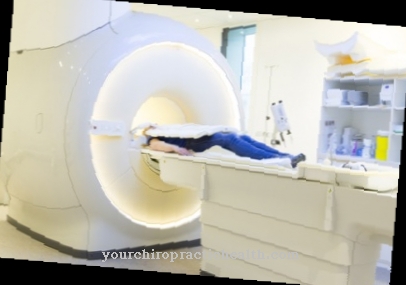Under the term of hysterectomy is understood as the surgical removal of the uterus. The term hysterectomy is also synonymous with hysterectomy Uterine extirpation used.
What is the hysterectomy?

The medical name hysterectomy comes from the Greek. Hystéra means uterus and the word ektome can be translated as cut off or cut out. If during the surgical removal of the uterus, i.e. the uterus, the ovaries are also removed, the procedure is known as a hysterectomy with adnexectomy (one or both sides).
Adnexen is the medical term for the ovaries. Often the subtotal hysterectomy is differentiated from the total operation. While the cervix is not removed in a supracervical hysterectomy, in a total operation the entire uterus is removed. Hysterectomy is usually done for benign diseases. The procedure is quite common in gynecological surgery. Possible indications are, for example, cysts or myomas. Around 150,000 hysterectomies are performed in Germany each year. 50 percent of all women are between 40 and 49 years old when their uterus is removed.
Function, effect & goals
The uterus can be removed for a number of reasons. Benign tumors and functional diseases of the uterus are the main indications for a hysterectomy. 90 percent of the operations are performed because of such diseases.
Menstrual irregularities are a possible indication. These are also known as cycle disorders. Here, anomalies in the rhythm of the bleeding can be distinguished from anomalies in the intensity of the bleeding. Additional bleeding or persistent bleeding in the absence of ovulation and the complete absence of menstruation (amenorrhea) also belong to the cycle disorders. One indication for a hysterectomy is mainly increased bleeding. While amenorrhea usually remains without problems for women, excessive bleeding can lead to anemia (anemia). The most common cause of a hysterectomy, however, is the uterus myomatosus. These are fibroids of the uterus. Fibroids are benign tumors that develop and grow under the influence of estrogens, progesterones and growth factors.
Often the women do not notice the fibroids. However, depending on the location and size, pain, constipation, discomfort when urinating or discomfort during sexual intercourse may develop. Due to the impaired regeneration of the mucous membranes, bleeding or even anemia can occur. In addition, pedunculated fibroids can twist and cause an acute abdomen. 17 percent of all hysterectomies are performed for endometriosis. Endometriosis is a benign, chronic disease that can cause severe pain.
The reason for this is the lining of the uterus that has settled in the body outside the uterus. For example, the ovaries, the vaginal wall, the intestines or even the lungs and brain can be affected. Like the normal lining of the uterus, the dispersed uterine lining reacts to the menstrual cycle. Endometriosis is a common cause of infertility. If the pain is too high due to endometriosis and there is no desire to have children, the uterus can be removed.
Another reason for a hysterectomy is uterine prolapse. With uterine prolapse, the uterus pushes itself through the birth canal to the vagina. The uterus can partially escape from the vagina.
In only 10 percent of all cases, the uterus is removed due to a malignant disease. Possible indications are malignant tumors of the ovaries, the cervix or the uterine body. A hysterectomy may also be necessary after injuries to the uterus or in the case of birth complications with insatiable bleeding. A rough distinction can be made between a simple hysterectomy, a hysterectomy with adnextomy, a hysterectomy with pelvic floor surgery and a total operation. The choice of the surgical procedure depends on various factors. The indication, the size and shape of the uterus, the mobility of the uterus, the experience of the surgeon and the equipment of the clinic all play a role in the decision-making process.
In vaginal hysterectomy, the uterus is removed through the vagina. Laparoscopic hysterectomy, also known as TLH or total laparoscopic hysterectomy, is performed using a laparoscope and other instruments inside the abdominal cavity. The laparoscopic and vaginal hysterectomy procedures can be combined. In laparoscopically assisted hysterectomy (LAVH), the uterus is operated on laparoscopically and removed through the vagina. A laparotomy can also be performed while preserving the cervix. This operation is also called a subtotal or supracervical abdominal hysterectomy.
The total abdominal hysterectomy is performed using an abdominal incision without preserving the cervix. When removing it through the vagina, the cervix is also removed. The abdominal and laparoscopic surgical procedures have the option of preserving the cervix. With both procedures, the fallopian tubes and ovaries can be removed at the same time. Of course, this additional removal should only be carried out if there is a corresponding indication.
In some stages of cervical cancer, radical hysterectomy according to Wertheim-Meigs is the procedure of choice. This is where the uterus, its holding apparatus, the upper third of the vagina and the pelvic lymph nodes are removed.
Risks, side effects & dangers
It should be noted that hysterectomy leads to total infertility in a woman. In women who want to have children, the uterus should only be removed if there is no other option.
Wound healing disorders or injuries to the ureter, urinary bladder and intestine rarely occur when the uterus is removed. Secondary bleeding can also occur. Further complications of hysterectomy are urinary tract infections, hernias, adhesions, painful intercourse and subsidence.

.jpg)

























